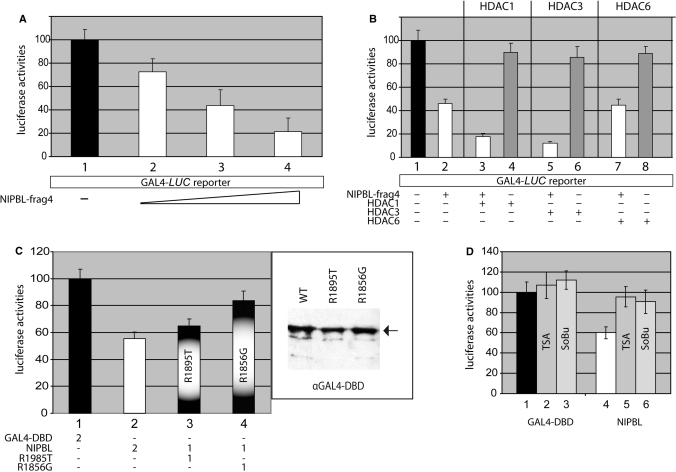Figure 3.
NIPBL-mediated recruitment of HDACs induces transcriptional repression. (A) The HDAC-interacting region of NIPBL, fragment 4, was fused to GAL4-DBD to obtain a GAL4-DBD-NIPBL-frag4 construct (NIPBL-frag4). Cells carrying a luciferase reporter with GAL4-consensus binding sequences 5′ to a LUC reporter gene were transfected with increasing amounts of NIPBL-frag4. The luciferase activity of cells transfected with an empty GAL4-DBD plasmid was set as 100% (column 1). NIPBL-frag4 reduces the reporter activity in a concentration-dependent manner (compare columns 1 with 2–4). (B) Cotransfections with HDAC1- as well as HDAC3-encoding plasmids enhance the transcriptional repression mediated by NIPBL-frag4 (columns 3 and 5), while transfection with HDAC6 does not alter the activity (column 7). As control, the effects of the individual HDAC on the reporter (HDAC1, 3, 6 and columns 4, 6, 8) were monitored in the absence of NIPBL. (C) Whereas missense mutation R1895T only slightly decreases the NIPBL-mediated activity (column 3), mutation R1856G severely reduces the activity (column 4). Equal expression of wild-type and mutant constructs was monitored by the use of an anti-GAL4-DBD antibody in western blots. (D) The effect of TSA and sodium-butyrate (SoBu) on the trans-repressive activity of the NIPBL-frag4 construct was assessed in COS7 cells. Columns 1–3 show the activities of cells tansfected with the empty GAL4-DBD plasmid. Here, TSA and SoBu only very slightly increase the activities. Columns 4–6 represent the results of cells transfected with the NIPBL construct. While the transfection with NIPBL-frag4 decreases reporter gene activity down to 50% in nontreated cells (column 4), treatments with TSA and SoBu, respectively, almost completely abolish the trans-repressional effect of NIPBL (columns 5 and 6). Experiments were done at least in triplicates and the standard deviations are indicated by error bars.

